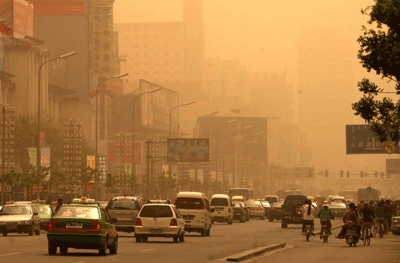| Reuters |
| Aug 16, 2006 |
| Beijing |
 |
|
|
The
City of Huhhot, capital of North China's Inner Mongolia
Autonomous Region, is shrouded in a dusty mist as a severe
sandstorm hit the central part of the region, with
visibility
reduced to 200 meters [Xinhua]
|
|
BEIJING,
Aug 16 (Reuters) - Inner Mongolia, source of a lot of the sand
and dust that envelops large parts of China every spring, needs
more help to fight the storms, a government official said on
Wednesday. While lauding progress made to date, Mo Jiancheng,
Inner Mongolia's propaganda chief, said more needed to be done
to solve the problem, in which the northern region had invested
more than 20 billion yuan ($2.51 billion) in the last six years.
"It needs
to be said, even though I'm unwilling to, that we still need
more attention to be paid, and need the state to keep providing
proactive support," he told a news conference.
Sand
storms earlier this year covered homes, streets and cars in
brown dust and left the skies a murky yellow across much of
northern China.
Desertification of the country's west and Mongolian steppes has
made spring sand storms worse in recent years, reaching as far
away as South Korea and Japan and turning rain and snow yellow.
Mo said
part of the problem was that the government left dealing with
the dust storm issue for too long.
"This is a
historical problem," he said. "When I was growing up in Inner
Mongolia there were more dust storms than now, but back then
people thought nothing of them. They cared little for the
quality of the weather and there were no pollution indices."
Inner
Mongolia borders Mongolia and Russia to the north and occupies
about 12 percent of China's land area.
Government
officials have said they are sure control efforts mean dust
storms will not bother the 2008 Beijing Olympics, but admit they
will never totally find a solution as too much of the country --
about a third -- is covered by desert.
As well as
planting trees in Inner Mongolia, the government has restricted
grazing, the traditional livelihood of the some four million
ethnic Mongolians who live in the region.
Exile
groups accuse the government of using the environment as an
excuse to further pressure the Mongolian community, who are now
outnumbered by Han Chinese by about five to one in Inner
Mongolia thanks to decades of internal migration.
"The
forced eviction of ethnic Mongolians is really intended to
complete the Chinese government's long-term goal of eliminating
the ethnic Mongolian population and traditional culture," the
Southern Mongolian Human Rights Information Centre says on its
Web site (www.smhric.org).
Mo
declined to answer questions about ethic tensions in Inner
Mongolia when asked after the news conference, saying he "did
not have time".
($1=7.981
Yuan) |





